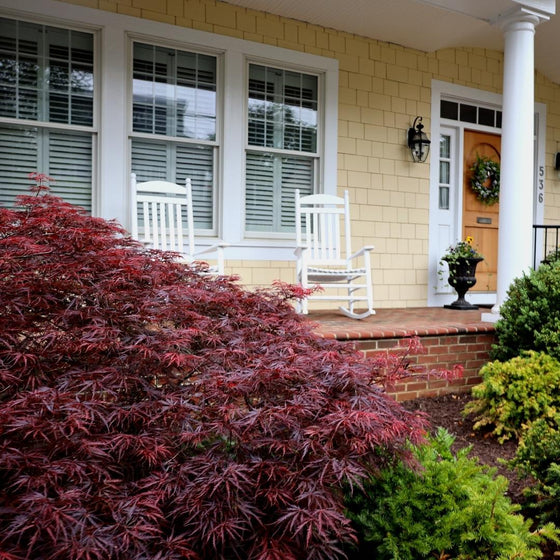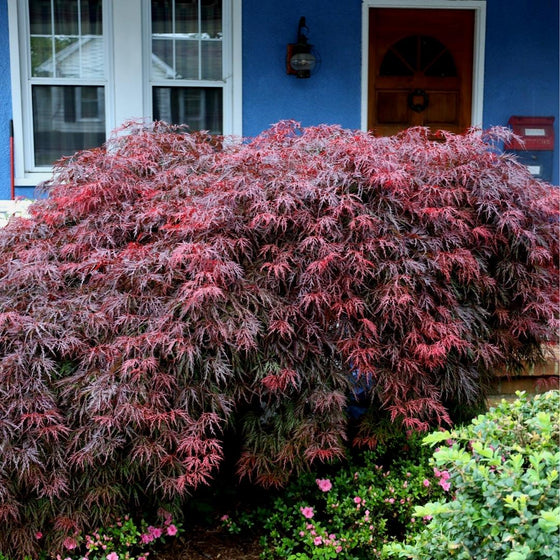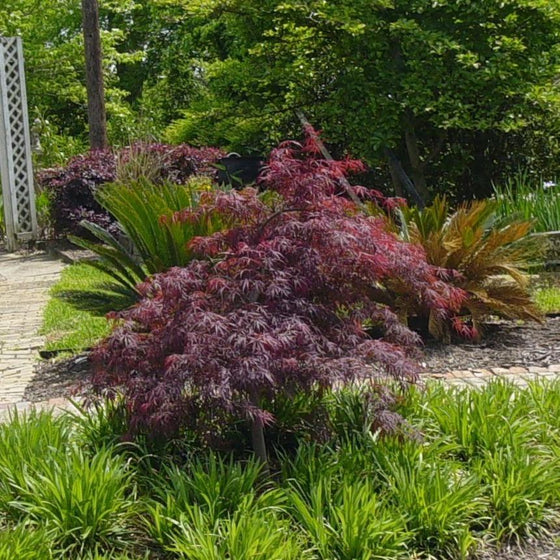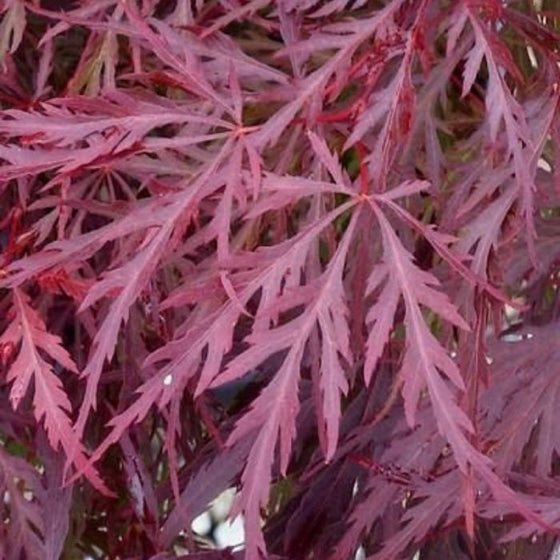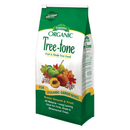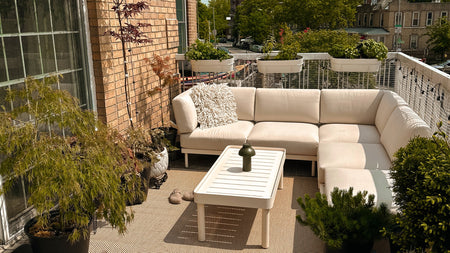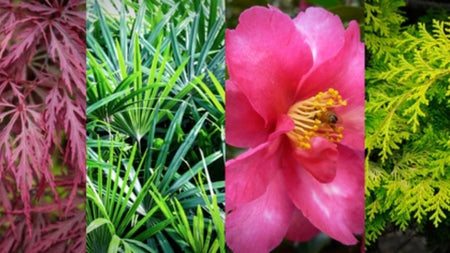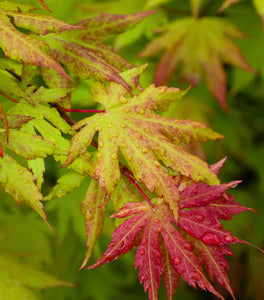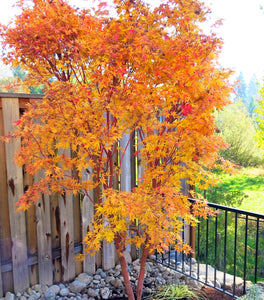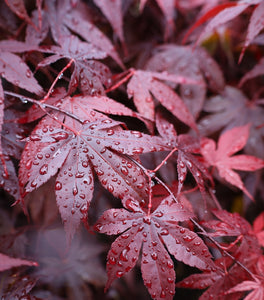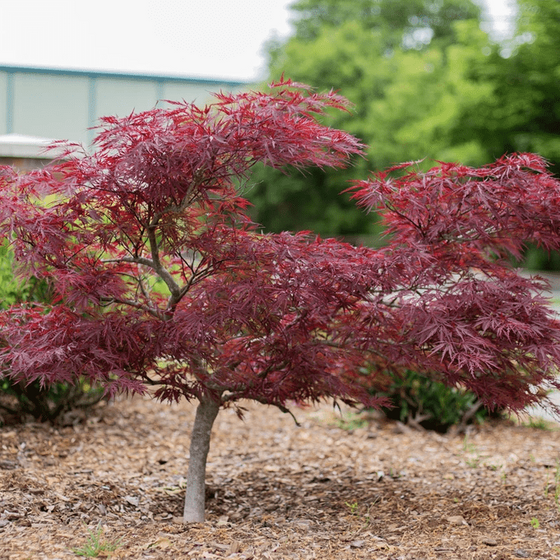
Images Depict Mature Plants
Red Dragon Japanese Maple Trees
The Red Dragon Japanese Maple is a compact, ornamental tree prized for its vibrant foliage, graceful form, and exceptional versatility in the landscape. This dwarf laceleaf Japanese Maple showcases deeply cut, feathery leaves that emerge as a rich crimson-red in spring, deepen to burgundy in summer, and shift to a brilliant scarlet in fall. With its weeping growth habit and finely textured foliage, Red Dragon creates a dramatic focal point in garden beds, containers, or as a stunning accent near entryways and patios.
Reaching a mature height of just 6 to 8 feet with a similar spread, Red Dragon Acer palmatum dissectum is ideal for small gardens, urban courtyards, or shaded woodland edges. Its cascading branches form a dome-shaped canopy, offering architectural beauty and visual softness when paired with evergreens, hostas, or ferns. Red Dragon thrives in part shade to full sun with protection from harsh afternoon rays and prefers well-drained, slightly acidic soil for optimal performance.
Low-maintenance and deer-resistant, the Red Dragon Japanese Maple tree is an outstanding choice for gardeners seeking reliable color, compact size, and four-season interest. It grows slowly and is easy to shape with minimal pruning, making it perfect for container gardening, Asian-inspired landscapes, or formal planting schemes. Add this brilliant maple to your landscape and enjoy its fiery foliage and elegant structure for years to come.
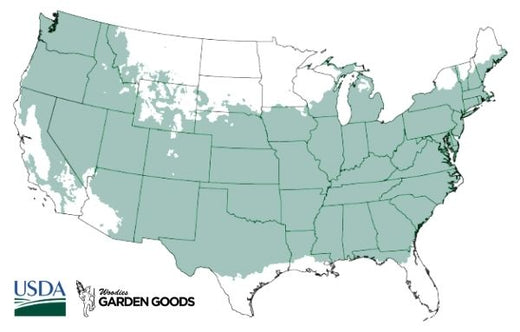
| Hardiness Zone: | 5-8 |
|---|---|
| Mature Height: | 7 to 8 feet |
| Mature Width: | 6 to 10 feet |
| Classification: | Small tree |
| Sunlight: | Part to full sun |
| Habit: | Deciduous, densely branched |
| Flower Color: | Insignificant |
| Foliage: | Dark purple to red foliage |
| Soil Condition: | Any well drained soil |
| Water Requirements: | Water well until established |
| Uses: | Extremely attractive when used as a focal point or a specimen planting, very slow growing |
How to Care for Red Dragon Japanese Maple
Before you buy a Red Dragon Japanese Maple Plant, make sure to read about the care instructions that are required and recommended to keep this plant healthy and thriving.
How do I plant a Red Dragon Japanese Maple Tree?
Planting a Red Dragon Japanese Maple tree begins with selecting the right location. This dwarf ornamental thrives in part shade to full sun, but in hotter climates, it benefits from protection against intense afternoon rays to prevent leaf scorch. Choose a spot with well-drained, slightly acidic soil, and dig a hole that is twice as wide and just as deep as the root ball. Gently loosen the roots before placing the tree in the hole, making sure the top of the root flare is level with or slightly above ground level. Backfill with a mix of native soil and organic compost, then water thoroughly to eliminate air pockets. To give your Red Dragon Acer palmatum dissectum the best start, apply a 2–3 inch layer of mulch around the base, keeping it a few inches away from the trunk to prevent rot. This helps retain soil moisture and regulate temperature. Avoid planting too deep or in overly wet areas, as this maple prefers consistent moisture but not soggy conditions. Proper spacing is also key—allow 6 to 8 feet of room for mature spread. With thoughtful placement and care during planting, your Red Dragon Japanese Maple will quickly establish itself as a stunning, low-maintenance focal point in your garden.
How do I water Red Dragon Japanese Maples?
Watering Red Dragon Japanese Maples properly is essential to establishing a healthy root system and maintaining vibrant foliage. During the first growing season after planting, provide deep watering 2–3 times per week, depending on your climate and soil conditions. Focus on soaking the root zone rather than light surface watering. Use a slow drip or soaker hose to ensure water penetrates deeply, encouraging roots to grow downward and helping the tree become more drought-tolerant over time. Monitor soil moisture by checking a few inches below the surface—if it feels dry, it’s time to water. Once established, Red Dragon Japanese Maples require less frequent watering but still benefit from consistent soil moisture, especially during periods of drought or high heat. Water thoroughly once a week during dry spells, and increase frequency during extreme summer temperatures. Avoid letting the soil become soggy or waterlogged, as this can lead to root rot. A 2–3 inch layer of organic mulch around the base helps retain moisture and protect the roots from temperature fluctuations. Proper watering ensures your Red Dragon Maple maintains its brilliant burgundy-red foliage and graceful weeping form throughout the season.
How do I fertilize Red Dragon Japanese Maples?
Fertilizing Red Dragon Japanese Maples correctly supports healthy growth, brilliant foliage color, and strong branching structure. For best results, apply a slow-release, balanced fertilizer (such as 10-10-10 or a fertilizer formulated specifically for Japanese maples) in early spring as new growth begins to emerge. Avoid high-nitrogen lawn fertilizers, as they may promote excessive leafy growth at the expense of vibrant red color and natural form. Spread the fertilizer evenly around the root zone, staying several inches away from the trunk, and water it in thoroughly to help nutrients reach the roots. In addition to spring feeding, you can apply a light dose of fertilizer again in late spring or early summer if your Red Dragon Japanese Maple tree is young or newly transplanted. Avoid fertilizing in late summer or fall, as this can encourage tender new growth that may not harden off before winter. Amending the soil with compost or organic matter annually also helps maintain nutrient-rich, well-draining soil conditions. With the right fertilization schedule, your Red Dragon Maple will produce lush, finely cut foliage and maintain its stunning, compact form year after year.

How and When Should I Prune My Red Dragon Japanese Maples?
Pruning Red Dragon Japanese Maples (Acer palmatum dissectum ‘Red Dragon’) should be done with care to preserve their natural, cascading form and showcase their finely textured foliage. The best time to prune is in late winter to early spring, just before new growth begins. During this period, the tree is dormant, making it easier to see its branch structure and make clean, precise cuts. Focus on removing any dead, damaged, or crossing branches, as well as any shoots that disrupt the tree’s graceful, weeping shape. Always use clean, sharp pruning tools to prevent disease and make smooth cuts that heal quickly. Light, corrective pruning can also be done in mid to late summer, once the tree has fully leafed out. At this time, you can thin out dense interior growth to improve air circulation and light penetration, which helps prevent fungal diseases and maintains the tree’s elegant silhouette. Avoid heavy pruning or shaping that removes large limbs, as this can stress the tree and spoil its natural appearance. With thoughtful, seasonal maintenance, your Red Dragon Japanese Maple will continue to display its vibrant burgundy foliage and striking architectural form throughout the year.

